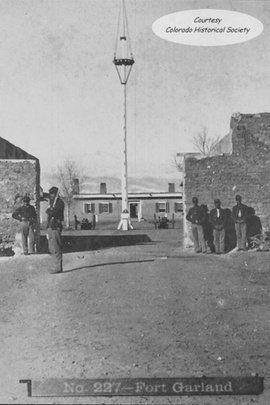The Story of Fort Garland: 1858 - 1883

African Americans of the Ninth Calvary at the sally port (main entrance) into Fort Garland, 1874. These men became known as Buffalo Soldiers, a name bestowed upon them by Southern Plains Indians
Western expansion fueled the need for frontier forts. The primary purpose of these forts was to keep the peace between the settlers and the indigenous people.
In 1852 the U.S. government saw the need for a military presence in the San Luis Valley and built Fort Massachusetts, the area’s first stronghold. It soon became clear that the location of Fort Massachusetts was not strategically practical. It was vulnerable to attack from higher ground and it was too far from the settlers it was intended to protect. Brig. Gen. John Garland, then commander of the Ninth Military Dept., issued orders for a new post to be built 6 miles south between the Ute and Sangre de Cristo creeks.
The buildings of the new fort were built of adobe mud bricks and the layout of the fort echoed that of other contemporary military posts in the West. It consisted of a rectangle of single-story buildings featuring a sally port (main entrance) on the south side. The rectangle encompassed a grassy parade ground lined with cottonwoods and a flagpole in the center. As originally constructed, the fort could accommodate seven officers and two companies of one hundred men each.
In 1861 the American Civil War was moving west, two companies of Colorado Volunteers were mustered into federal service at Fort Garland and marched to bolster forces against the Texan Confederates, who were attempting to capture the West. With the defeat of the Texans near Santa Fe at Glorieta Pass in 1862, the West was saved for the Union.
After the Civil War, from 1866 to 1867, Christopher "Kit" Carson commanded the New Mexico Volunteers at Fort Garland. Drawing on his knowledge of American Indian languages and culture, he worked with Chief Ouray and other Ute leaders in negotiating peace between Utes and others in the Valley that lasted more than a decade.
The Ninth Cavalry of the famed Buffalo Soldiers was stationed here between 1876 and 1879 after having served in Texas. In 1876, troops marched to the La Plata region to prevent conflict between the Utes and white prospectors. The following year, they helped remove white settlers from Ute reservation lands.
The peace in Colorado was shattered on Sept 29, 1879, when a band of Utes killed Indian Agent Nathan Meeker and 11 others at the White River Agency in northwest Colorado. The incident raised the specter of all-out war and in anticipation the garrison at Fort Garland expanded to 15 companies, most of which had to live in tents during a brutal snowy winter. Within a year, the Utes were militarily escorted out of their centuries-old central Rockies home and directed to sagebrush reservations in eastern Utah or smaller reservations in southern Colorado.
Fort Garland was in use for 25 years, a long time for a frontier fort. The coming of the railroad and the removal of American Indians marked the end Fort Garland in 1883.

Civil War Reenactors



